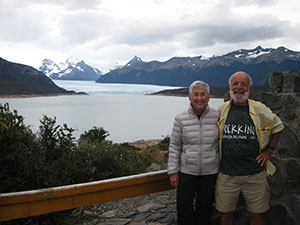Scientists have a responsibility to society to make the world a better place.
 “With those words,” says David Mog (PhD ’70), “Harrison Brown helped me realize that, rather than simply focusing on personal accomplishments, I could work toward making a real difference in the world.”
“With those words,” says David Mog (PhD ’70), “Harrison Brown helped me realize that, rather than simply focusing on personal accomplishments, I could work toward making a real difference in the world.”
Harrison Brown, a professor of geochemistry at Caltech from 1951 to 1977, was a forbear of sustainability science and an early seeker of solutions for impending problems related to population growth and pollution. As foreign secretary of the National Academy of Sciences (NAS), he helped bring global consciousness to the emerging needs of developing countries.
After he received his PhD in chemistry in 1970, Mog and his wife, Gloria Mog, relocated to South America, where he worked for three years on science and engineering initiatives to enhance the well-being of people in Brazil. Back in the United States, he went on to the chemistry departments at Oberlin College and Princeton University before joining NAS, where he was employed for the better part of a decade.
In 1990, Mog was traveling to India with the NAS Office of International Affairs when a fellow passenger administered a wake-up call to his inner teacher. The traveler seated beside Mog was Roger Revelle, then director of Scripps Institution of Oceanography. An early and influential predictor of global warming, Revelle described the enormity of problems that come with climate change. The message hit home for Mog.
“I am proud of the impact I had on close to 1,000 students. Many have a deep appreciation of their responsibilities as citizens in caring for the planet.”
"I attended as many, or maybe even more, biology and geology seminars at Caltech as I did chemistry," Mog recalls. "That broad and interdisciplinary education helped me see Revelle's big-picture view right away." The conversation convinced Mog of the need for informed, scientifically literate voters to help safeguard the health of our planet and renewed his passion for science education.
A few years after his encounter with Revelle, Mog left NAS to work at Sidwell Friends School, a renowned college-prep school near the nation's capital. Mog taught science there until his retirement in 2009. "I am proud of the impact I had on close to 1,000 students,” he says. “Many are now involved in environmental work, and many more have a deep appreciation of their responsibilities as citizens in caring for the planet.”
Mog's years as a student and as an educator were particularly rewarding times in his life, and he has remained connected to both Sidwell and Caltech. After making numerous gifts to Caltech over the decades, the Mogs recently gave their largest one to date, in the form of a flexible charitable gift annuity (CGA). The Mogs are among the 39 percent of Caltech alumni who have made a gift to their alma mater as part of Breakthrough: The Caltech Campaign.
“The Caltech community cared about us when we were younger, and now that we are elders, we get to help take care of it," David Mog says.
Gloria Mog, who was a social worker for many years, recommends the flexible CGA as a gift-giving vehicle for people who feel anxious about not knowing how much to save for the future. "With the flexible CGA," she explains, "we can make a donation now and don't have to decide until later whether the payout from the annuity goes to Caltech or comes back to us."
David Mog chimes in: “The beauty of the CGA is that we can give in a way that will make a lasting difference that starts in our lifetimes. At the same time, it's set up to give us peace of mind because if we need extra income later, Caltech will be there for us."
 ONE DEGREE OF SEPARATION
ONE DEGREE OF SEPARATION
As it turns out, David Mog and Roger Revelle shared more in common than a passion for science and an airplane armrest on a flight to India.
In 1956, Revelle had recruited another Harrison Brown advisee, Charles Keeling, to help establish a CO2-monitoring station at Mauna Loa Observatory in Hawaii. At Caltech, Brown encouraged Keeling—his first postdoctoral scholar—to conduct environmental research that required comparisons of carbon dioxide concentrations from air and water samples. But the work couldn’t move forward using existing instrumentation. So Keeling invented a new tool, conducting his first tests of the instrument on the roof of Caltech’s Seeley G. Mudd Building of Geophysics.
Keeling’s device has been monitoring levels of CO2 in the atmosphere since 1958. Its measurements have been plotted into one of the most influential scientific graphs in human history: the Keeling Curve.


